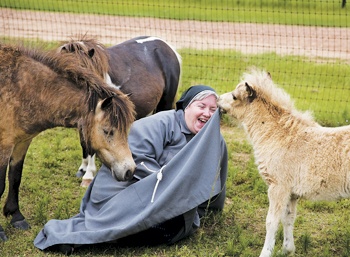It’s October, and the sky is a deep blue color that occurs only on a perfect autumn day. It’s warm but not hot, and the sky is so clear that it seems you could see a thousand miles from the right hilltop. It’s a great day to be headed out of the city and into the country on a drive that will take me to Brenham to see the miniature horses at the Monastery of St. Clare.
The monastery is run by the Franciscan Poor Clare Nuns, a nonprofit religious organization devoted to a contemplative life of prayer. In an operation called Monastery Miniature Horses, the nuns raise and sell the tiny equines to support their community.
When I arrive, I check in with Sister Angela, the abbess of the monastery as well as chief miniature horse wrangler. She is busy with customers in the gift shop, so I agree to talk with her later. It’s the annual AutumnFest at the monastery, and there are dozens of families out for the day to play games, eat snacks and pet the horses. While I wait for Sister Angela, I wander out to a pasture where several of the horses are standing in the shade.
As I lean against the fence, three of the little guys come over to take a look. They stand quietly, gazing at me with gentle curiosity. I gaze back and find myself mentally slowing down and breathing deeper. It feels almost like meditation. The horses are just hanging out, being themselves, but their gaze is attentive and accepting. By some mysterious process, they transfer their calmness to me. This moment alone is worth the drive to Brenham.
Though each horse has a personality all its own, the horses are bred to be calm and friendly, Sister Angela says. Approach a corral fence, and they’ll almost always come over to check you out. Their coats are denser and fuzzier than that of most standard-sized horses, and the fuzz on their faces is particularly soft. When they poke their heads through the fence, it’s obvious that they want to be touched.
The nuns first began raising the miniature horses in Corpus Christi in 1981, at the behest of Sister Bernadette, the abbess at that time. Sister Bernadette, who died in 1990, was an animal lover and believed that the horses could provide the revenue needed to support the community.
Sister Angela, who became abbess and manager of the horse farm after Sister Bernadette’s death, says the monastery sells 12 to 15 horses a year, earning from $500 to $5,000 each, depending on the horse’s age, training and breeding ability. The nuns supplement this income with entrance fees from an estimated 20,000 visitors each year and the sales of ceramics produced in their Art Barn.
Throughout the 1980s and 1990s, the monastery bred and trained 70 to 100 horses a year, but not all of the horses belonged to the monastery. Some of the horses were bred at the monastery, while others were brought there for training. During those years, a well-trained horse might have sold for several thousand dollars.
In 1984, the Sisters of St. Clare bought a former cutting-horse farm 7 miles outside Brenham on State Highway 105 and moved the monastery. There, a chapel and living quarters were built for the nuns.
According to John Garza, who ran the monastery’s breeding and training program from 1981 to 1996, there were fewer than 20 breeders in the United States in 1981 and only about 2,500 to 3,000 miniature horses.
Over the past decade, however, competition has increased in the miniature horse world. Now, there are more than 100 breeders and nearly 160,000 horses registered with the American Miniature Horse Association (AMHA).
Meanwhile, the miniatures are just that: Sister Angela explains that the AMHA defines “miniature” as a horse that doesn’t exceed 34 inches in height. In all other respects, she says, they are genetically identical to full-size horses. The miniature horses typically are 16 to 21 inches tall at birth.
Garza, a volunteer for AutumnFest, says the horses were bred during the 17th century in Europe as pets for royalty. And it is believed that from the 1800s until about 1950, miniature horses were used as “pit ponies’’ in European and American coal mines, hauling carts to the surface.
Garza says miniature horses are a different breed from Shetland ponies—once also used in coal mines—which are famous for their less-than-amiable temperaments. Like Shetlands, however, miniatures are strong for their size and can be trained to pull a small cart. Some of the miniatures from the monastery are sold to owners who use them in cart-driving competitions.
Garza says the horses—which in many situations are used as therapy animals—mostly are sold as pets. “The minis are fun,” he said. “They are easy and inexpensive to care for, compared to a full-sized horse. Children love them, and they become a member of your family. They bond with you. And you can raise a couple of them in your backyard.”
In addition to petting the miniature horses, you can have a picnic on the monastery grounds (drinks and snacks are available for purchase) or create your own hand-painted ceramic horse. The nuns offer molded bisque ware models of horses (and a wide variety of other animals) that they make, and they provide all you need to decorate your piece. You may also purchase the exquisite hand-painted ceramics created by the nuns.
——————–
Karen Branz Leach is an Austin-based freelance writer.


